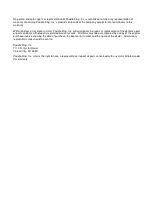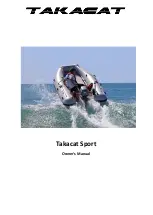
VI. General Rules of Seamanship
•
Cross waves at right angles.
•
When caught in heavy water or squalls, head either directly into the waves or at a slight angle. Reduce
speed, but maintain enough power to maneuver your boat safely.
•
Keep your speed where you feel you have the most control of your boat. Respect the rights of boaters
engaged in swimming, water skiing, diving or fishing. Never follow behind a water skier or someone being
pulled behind a boat.
•
When meeting a boat head-on, keep to the right whenever possible.
•
When two boats cross, the boat to starboard has the right of way.
•
When overtaking or passing, the boat being passed has the right of way. The boat being passed is required
to maintain the same course and speed.
•
Sail boats always have the right of way.
Stopping:
You cannot stop your boat as quickly as you do a car. To stop the boat, slow your speed to 5 M.P.H. or
less, then put the engine in reverse. By slowly increasing the reverse power, you can stop the boat in a short
distance. Keep in mind that the boat steering is not as responsive in reverse as in forward.
Anchoring:
You may want to anchor your boat for recreational purposes, such as fishing, or in an emergency. The
weight of your anchor and size of your anchor line depends on the size and weight of your boat. A light-weight
burying anchor grips into the bottom and holds your boat secure. An anchor will usually hold best in a mixture of
mud and clay or in hard sand. Holding power should be more important than weight. Your dealer can help you
select the proper anchoring equipment.
The length of the anchor line should be six to eight times the depth of the water to assure that the anchor bites into
the bottom. The bottom end of the anchor line should be galvanized chain. The rest of the line should be nylon
anchor line.
•
Secure the anchor line to the bow deck cleat or eye. Do not tie the line to hardware that is not designed to
support this stress. Do not attach the anchor at the stern. A small current will make the boat unsteady. A
strong current can pull a boat anchored by the stern, under water and keep it there.
•
If you are anchoring for more than a few hours, use more than one anchor. If you use only one anchor,
make sure your boat has enough space to swing full circle in case of shifting winds.
•
Keep the anchor and line in an area on your boat where it will be readily available in an emergency.
Dropping Anchor:
•
Attach end of line to the bow deck cleat or eye.
•
Maneuver the boat into the wind or current, over the spot where the anchor is going to be. Turn motor off
and carefully lower the anchor and make sure it has “caught.”
•
Take a mental note of landmarks and check them after about a few minutes to make sure you have not
drifted. Re-check position periodically.
Weighing Anchor:
•
To weigh or pull the anchor in, you need to pull the boat back toward the anchor by pulling on the anchor
line.
•
When the line is vertical, pull up firmly.
•
If the anchor gets stuck, feed out a few feet of line and attach it to the bow cleat. Maneuver the boat around
the anchor, keeping the line taut until you find an angle that will pull the anchor free.
Docking:
•
Always approach the dock slowly. If possible, come in against the wind or current, whichever is stronger.
Come in at 30-45° angle. As the boat nears the dock, slowly swing parallel to it.
•
If wind or current is moving toward the dock, move parallel to the dock further out. Let the wind or current
push you in. Approach slowly at a slight angle with engine in slow reverse. Gently swing parallel. Use
extreme caution when the wind or current is from your stern. Turn off motor.
Summary of Contents for Lo Pro Cruiser
Page 23: ......









































